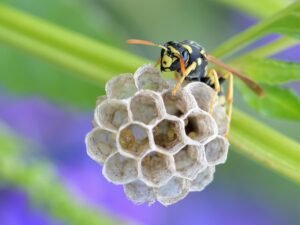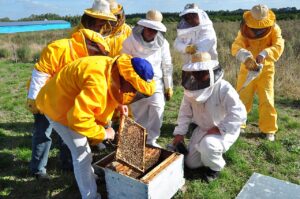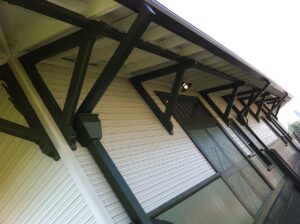Wasps are one of those pests that can turn a peaceful afternoon in your yard into a stressful event. If you spot a growing nest near your eaves, it’s time to safely remove the wasp nest before it becomes a danger to your family. Whether you’re handling it yourself or calling a professional, dealing with wasps requires caution, patience, and the right approach. As a pest control technician specializing in specific pest problems, I’ve helped countless homeowners safely remove wasp nests and prevent future infestations. Here’s what you need to know if you discover a wasp nest near your home.
Understanding the Threat Wasps Pose and Why Safe Removal Matters
Wasps are highly territorial insects that become aggressive when they perceive a threat to their nest. Their sting is painful and can cause severe allergic reactions in some people, even if they’ve never had one before. A single wasp sting can be bad enough, but when wasps swarm, the risk increases significantly.
I once helped a family who had unknowingly allowed a yellow jacket nest to grow large near their patio. The parents thought it was safe because it wasn’t causing any problems, but their kids accidentally disturbed it while playing ball. Later, they admitted they had been throwing a baseball and rocks at the nest! After several painful stings, they realized they needed professional help. This story shows why it’s important to address a potential problem early, rather than wait for an incident to occur.
Common Nest Locations

Wasps like to build their nests in sheltered locations. Around your home, this might include:
- Under eaves or rooflines. ( Paper / Umbrella Wasps )
- Inside outdoor light fixtures. ( Mud Daubers )
- In sheds, garages, or under decks. ( Paper & Mud Daubers )
- In bushes, trees, or even holes in the ground (common for yellowjackets).
Keeping an eye on these spots during spring and summer can help you catch potential problems early.
Step 1: Assess the Situation
When you spot a wasp nest, your first step is to evaluate the size and location. Is it close to a frequently used area, like your front door or patio? If so, it’s more of a priority to address. Is it still small and inactive, or has it grown into a large, buzzing hub of activity?
Why Time of Day Matters for Safe Wasp Nest Removal

Wasps are less active during the early morning or late evening when temperatures are cooler, making these times the safest for observing the nest or making a plan. Avoid approaching the nest during the day when wasps are most active. Most wasps will allow you to approach if you don’t disturb them, but the warmer it gets, the more active and aggressive they become. Be especially cautious around yellow jacket nests, as they can be more aggressive.
Decide Whether to Call a Professional to Safely Remove the Wasp Nest
Although it might be tempting to handle a wasp nest on your own, I generally recommend calling a professional pest control service, except in the case of Mud Daubers. Here’s why:
The Right Tools and Gear for Safely Removing a Wasp Nest

Professionals have specialized protective gear that keeps them safe from stings, even during large or aggressive nest removals. They also have access to professional-grade treatments that ensure removal.
Eco-Friendly Solutions for Safe Wasp Nest Removal
Many pest control companies, including mine, prioritize eco-friendly methods that are safe for your family, pets, and the environment. In many cases, nests can be safely removed without the use of chemicals.
Professional Help Guarantees Safe Wasp Removal
One of the biggest mistakes I see is incomplete nest removal. If even a small part of the nest or the queen survives, wasps can rebuild quickly. Professionals ensure the nest is entirely removed, reducing the chances of a return.
Step 3: How to Safely Remove a Wasp Nest Yourself
If calling a professional isn’t an option, here are some tips for handling a wasp nest safely:
1. Gear Up for Safety
Before approaching a nest, wear long sleeves, a hat, and clothing that covers your skin. If using a chemical treatment, be sure to wear gloves and eye protection. Cover as much skin as possible to minimize the risk of stings, and avoid bright colors or floral patterns that may attract wasps.
2. Use the Right Tools
For small mud dauber and paper wasp nests, you can knock them down with a long object, such as a broom, or use an over-the-counter spray. Use an applicator or an aerosol designed for long-range application. Stand at a safe distance and spray directly onto or into the nest opening, preferably in the early morning or evening.
3. Stay Calm and Move Slowly
Wasps are more likely to sting if they perceive quick or jerky movements as a threat. Approach calmly, spray, and retreat slowly. Never swat at individual wasps, as this can provoke the entire colony.
4. Finishing up
If you’ve used a chemical treatment, you’ll still need to remove the nest. Once the wasps are gone, knock the nest down. With mud daubers, there will likely be residue left on the surface. A pressure washer or a bucket of water with a stiff brush works well for cleaning it up. If you didn’t use chemicals and just knocked the nest down in step 2, verify that it’s empty; wasps usually leave but repeat the process if necessary.
Step 4: Prevent Future Wasp Nests Around Your Home
The best way to handle a wasp nest is to prevent it from forming in the first place. Here are some tips for keeping your home and yard less attractive to wasps:
Seal Entry Points for Safe Wasp Nest Removal

Inspect your home’s exterior for cracks, gaps, or holes, especially near eaves, vents, and window frames. Seal these openings to prevent wasps from nesting inside. Insect screen, caulking and expanding foam are the common tools of the trade.
Eliminate Attractants to Prevent Wasp Nests Safely
Wasps are attracted to food and sugary drinks. Keep trash bins tightly sealed, clean up food spills promptly, and avoid leaving meat or sugary foods outside. To prevent mud daubers, avoid overwatering that creates mud.
Keep Outdoor Areas Clear to Prevent and Safely Remove Wasp Nests
Regularly inspect and remove vegetation that creates a habitat for wasps, such as rotting tree hollows. Wasps prefer to build nests in these sheltered spots, so keeping vegetation trimmed can help make your yard less inviting.
Proactive Monitoring
Check common nesting areas around your home periodically, especially in the spring when wasps start building nests. Removing small nests early is much easier than dealing with large ones. Additionally, many wasps return to their birthplace to lay eggs. Break the cycle!
A Personal Anecdote: Why I Always Recommend Professional Help to Safely Remove Wasp Nests
One summer, I was called to a home where a DIY attempt went wrong. The homeowner sprayed a large nest near their garage without protective gear, and the wasps retaliated. They ended up with several painful stings and a nest that wasn’t fully removed. After I arrived, I safely removed the nest, treated the area, and gave them tips to prevent future infestations.
This experience underscores why professional help is worth the investment. It’s safer, faster, and often more cost-effective in the long run.
Conclusion: Safely Remove Wasp Nests to Protect Your Family
Wasps are a nuisance, but they’re also a safety hazard when their nests are near your home. By assessing the situation, taking the right precautions, and knowing when to call a professional, you can handle wasp nests safely and effectively.
At Traffic Pest Solutions, we’re here to help local homeowners with safe, eco-friendly pest control. If you’re dealing with a wasp problem, don’t wait—give us a call today for a free consultation. Let’s keep your home safe, clean, and sting-free!
For more further guidance on safely handling a wasp nest, you can refer to this Michigan State University article on getting rid of wasp nests, which offers expert advice on identifying and managing nests in a safe and effective manner.

